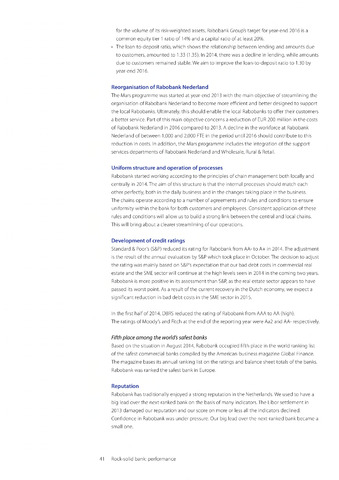for the volume of its risk-weighted assets. Rabobank Group's target for year-end 2016 is a
common equity tier 1 ratio of 14% and a capital ratio of at least 20%.
The loan-to-deposit ratio, which shows the relationship between lending and amounts due
to customers, amounted to 1.33 (1.35). In 2014, there was a decline in lending, while amounts
due to customers remained stable. We aim to improve the loan-to-deposit ratio to 1.30 by
year-end 2016.
Reorganisation of Rabobank Nederland
The Mars programme was started at year-end 2013 with the main objective of streamlining the
organisation of Rabobank Nederland to become more efficient and better designed to support
the local Rabobanks. Ultimately, this should enable the local Rabobanks to offer their customers
a better service. Part of this main objective concerns a reduction of EUR 200 million in the costs
of Rabobank Nederland in 2016 compared to 2013. A decline in the workforce at Rabobank
Nederland of between 1,000 and 2,000 FTE in the period until 2016 should contribute to this
reduction in costs. In addition, the Mars programme includes the integration of the support
services departments of Rabobank Nederland and Wholesale, Rural Retail.
Uniform structure and operation of processes
Rabobank started working according to the principles of chain management both locally and
centrally in 2014. The aim of this structure is that the internal processes should match each
other perfectly, both in the daily business and in the changes taking place in the business.
The chains operate according to a number of agreements and rules and conditions to ensure
uniformity within the bank for both customers and employees. Consistent application of these
rules and conditions will allow us to build a strong link between the central and local chains.
This will bring about a clearer streamlining of our operations.
Development of credit ratings
Standard Poor's (S&P) reduced its rating for Rabobank from AA- to A+ in 2014. The adjustment
is the result of the annual evaluation by S&P which took place in October. The decision to adjust
the rating was mainly based on S&P's expectation that our bad debt costs in commercial real
estate and the SME sector will continue at the high levels seen in 2014 in the coming two years.
Rabobank is more positive in its assessment than S&P, as the real estate sector appears to have
passed its worst point. As a result of the current recovery in the Dutch economy, we expect a
significant reduction in bad debt costs in the SME sector in 2015.
In the first half of 2014, DBRS reduced the rating of Rabobank from AAA to AA (high).
The ratings of Moody's and Fitch at the end of the reporting year were Aa2 and AA- respectively.
Fifth place among the world's safest banks
Based on the situation in August 2014, Rabobank occupied fifth place in the world ranking list
of the safest commercial banks compiled by the American business magazine Global Finance.
The magazine bases its annual ranking list on the ratings and balance sheet totals of the banks.
Rabobank was ranked the safest bank in Europe.
Reputation
Rabobank has traditionally enjoyed a strong reputation in the Netherlands. We used to have a
big lead over the next-ranked bank on the basis of many indicators. The Libor settlement in
2013 damaged our reputation and our score on more or less all the indicators declined.
Confidence in Rabobank was under pressure. Our big lead over the next-ranked bank became a
small one.
41 Rock-solid bank: performance

